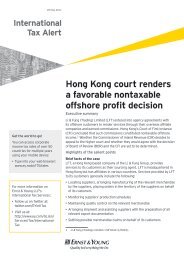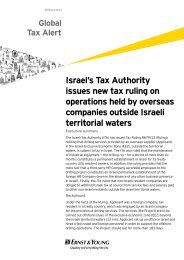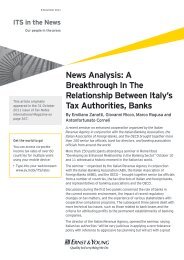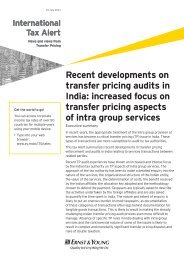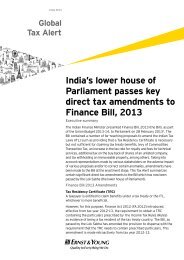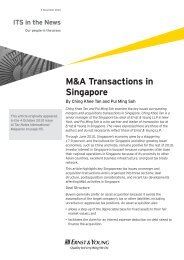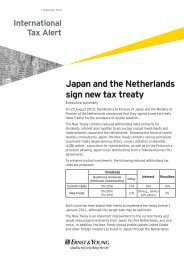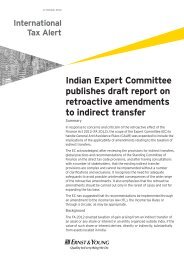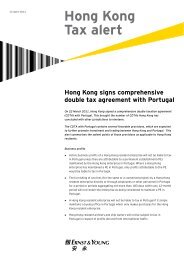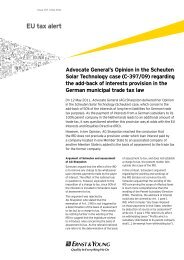Download - Ernst & Young T Magazine
Download - Ernst & Young T Magazine
Download - Ernst & Young T Magazine
You also want an ePaper? Increase the reach of your titles
YUMPU automatically turns print PDFs into web optimized ePapers that Google loves.
Feature The global executive<br />
people on assignment is hugely important,<br />
agrees Ferrigno. “You see people go with the<br />
wrong expectation to markets, thinking they are<br />
there to show and tell when they should be there<br />
to listen and learn,” he says. Indeed, appropriate<br />
metrics are a central part of defining the<br />
assignment properly. Global executives should<br />
not be evaluated against traditional business<br />
measures such as revenue goals, but they<br />
should also be measured on how well they are<br />
adapting to their assignment. “From there you<br />
can quantify the return,” says Schupp.<br />
A clearly defined assignment also helps<br />
significantly in finding the right person for the<br />
job. The ideal attributes of potential<br />
international executives is one of the most<br />
studied aspects of global transfers. But barring<br />
some obviously useful aspects – cultural<br />
sensitivity, ability to interact with others, and a<br />
desire to succeed – no definitive list exists.<br />
Inevitably, choosing a candidate is a balancing<br />
act between the talent available, the ability of<br />
candidates to thrive in a foreign environment,<br />
and the skills needed to do the particular job at<br />
hand. “There is no perfect test. Each case has to<br />
be looked at individually,” says Steele.<br />
Practical issues<br />
Once the job is defined, and the correct person<br />
found, international assignments throw up a wide<br />
range of challenges for the sending company.<br />
Many of these have long been present - from the<br />
basic need for appropriate visa and working<br />
permits, to the more complex need to align<br />
assignment strategies with overall business goals<br />
- but several are worth noting here given how they<br />
are changing. All of these issues are discussed in<br />
greater detail in other articles throughout this<br />
issue of T <strong>Magazine</strong>. Nevertheless, as the list<br />
highlights, there are many practical complexities<br />
of using global executives.<br />
The social network<br />
Any transferring executive has a network of social<br />
connections at home that will be disturbed as a<br />
result. This is especially true of close family. “It is<br />
also increasingly difficult to move some<br />
employees on assignment when their spouses<br />
work,” says Waty. “We do provide spousal support<br />
to find work in the new location and support to<br />
complete further education. Very often we can<br />
‘sell’ the assignment on the basis that it is a great<br />
experience for the whole family in terms of<br />
personal development.” A separate issue is that<br />
an increasing number of people may be together<br />
but not married, raising challenges over<br />
immigration rights. Addressing family issues is<br />
more than just a practical matter: it may define<br />
how well international executives fulfil their<br />
assignments. “Very often, if an executive has<br />
been successful, it is thanks to a spouse and<br />
family who have a global mindset,” says Waty.<br />
“Companies are not doing enough to assess how<br />
well the family can adapt.”<br />
Compensation arrangements<br />
As the goals of international placements evolve,<br />
payment arrangements need to keep pace. “If<br />
you send people around as part of their<br />
development, you are going to need to look at<br />
how these costs get people to take on the right<br />
challenges without overly enriching them,” notes<br />
Ferrigno. It might be valuable, therefore, to tie<br />
compensation to metrics designed around those<br />
challenges. Another current trend is for<br />
companies to use “localization” packages, with<br />
executives receiving a lump sum up front to<br />
cover moving costs, but then being compensated<br />
in the same way as their new local peers,<br />
including in terms of eligibility for bonuses. Not<br />
only does this control costs, but it leads to<br />
executives being taken more seriously by their<br />
colleagues because they now have an obvious<br />
stake in local success.<br />
Dealing with tax<br />
International employment has always brought<br />
income tax complications, but the current<br />
economic climate can make this even tougher.<br />
“Many countries are looking for additional<br />
sources of revenue, so revenue agencies are<br />
turning over rocks to make sure organizations<br />
are compliant on income or payroll tax,” notes<br />
Schupp. Over half of companies polled by<br />
<strong>Ernst</strong> & <strong>Young</strong> describe tax compliance as very<br />
challenging. Although the most pressing specific<br />
issues vary by jurisdiction, some tax issues have<br />
a growing profile internationally. For example,<br />
the payment of stock options to executives.<br />
Depending on where the executive is resident<br />
for tax purposes when these are earned and<br />
exercised, a variety of countries – which may<br />
or may not have relevant double taxation<br />
treaties – might wish to tax the proceeds.<br />
There is also the important need to adhere to<br />
social security obligations in all relevant<br />
jurisdictions.<br />
Bringing them back again<br />
“Assigning a person abroad creates a retention<br />
issue. It is not always easy to bring back a former<br />
assignee,” says Waty. Indeed, <strong>Ernst</strong> & <strong>Young</strong><br />
research indicates that just over 1 in 10 executives<br />
resign within two years of returning from foreign<br />
assignments. Given the significant investment<br />
made into the development of these executives,<br />
this can be a costly loss for any company.<br />
The broader picture is that the expat has, in<br />
recent years, evolved into the global executive.<br />
Within this, the key factors of who is being sent,<br />
why they are going, and where they are headed<br />
to, are all changing as companies have<br />
transformed themselves from centrally run<br />
multinationals to globally diverse enterprises.<br />
In order to manage this new species, however,<br />
businesses have to keep up. In particular,<br />
different functions in the company need to work<br />
together in a way that too few are currently<br />
doing.<br />
Percent of the total number<br />
of employees are long-term<br />
assignees (>12 months)<br />
12 T <strong>Magazine</strong> Issue 07 <strong>Ernst</strong> & <strong>Young</strong><br />
2008<br />
21%<br />
2011 2%<br />
9%<br />
18%<br />
7%<br />
6%<br />
9%<br />
73%<br />
64%<br />
Source: <strong>Ernst</strong> & <strong>Young</strong>’s Global Mobility<br />
Effectiveness Survey 2011



